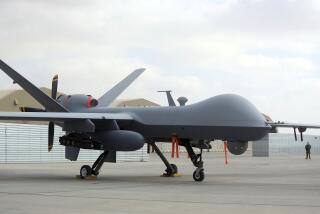U.S. Pilots Face Perilous Task, Pentagon Says
- Share via
WASHINGTON — If NATO orders airstrikes on Yugoslavia, U.S. pilots will confront a well-trained and motivated air defense force that may well knock down planes and cost pilots’ lives, U.S. defense officials said Friday.
Though their equipment is at least 15 years old, Serbian air defense troops are generally knowledgeable about U.S. tactics and protected by mountainous terrain and intemperate weather, officials said. In addition, because of their past fears of a Soviet air assault, the Serbs are well prepared and equipped to endure a bombardment.
U.S. military officials, worried that the public may have become too relaxed about possible U.S. military casualties after eight years of low-cost encounters with Iraq, have been warning that an air assault on Yugoslavia would probably not be entirely one-sided.
“These guys are very good,” Air Force Chief of Staff Gen. Michael Ryan, who oversaw the 1995 air campaign against Bosnian Serbs, told the Senate Armed Services Committee this week.
He said casualties are a “distinct possibility,” a view seconded by Marine Commandant Gen. Charles Krulak.
“It is going to be tremendously dangerous,” Krulak said.
The Serbian defenders have more air defense equipment and are better trained than the Bosnian Serb troops who battled NATO pilots during the 1995 airstrikes on Bosnia-Herzegovina. They are also more proficient and have more concentrated air defense equipment than the Iraqis, who have skirmished with U.S. and British pilots in Iraq’s “no-fly” zones since 1991.
The Serbs have about 60 surface-to-air missile batteries in Yugoslavia, including Soviet-built SA-2s and SA-3s and the relatively sophisticated Soviet-made SA-6s.
It was an SA-6 missile, hard to detect and capable of flying nearly three times the speed of sound, that knocked down an F-16 carrying U.S. combat pilot Capt. Scott F. O’Grady during an air patrol over Bosnia in June 1995.
He was rescued after surviving in a war zone for six days on insects, grass and rainwater.
Ryan said the network of batteries represents “a very substantive air defense capability” and includes a heavy concentration of antiaircraft artillery, which is used for lower-flying planes. The Serbs, he added, have a “very professional army and air defense corps.”
NATO has about 400 aircraft in the region--including about 200 U.S. planes--and six warships capable of launching cruise missiles.
Yugoslavia is made up of a series of interlocking valleys, ringed in part by mountains. Stormy weather is expected intermittently in the region throughout much of the spring, defense officials said. Cloud cover and fog make it harder for pilots to see targets and, in some cases, can force a temporary interruption of an air campaign.
Fearing a Soviet air attack, Yugoslav forces have practiced air defense drills and refined techniques for four decades. In that time, they stockpiled ammunition and buried communication lines and other air defense infrastructure to help ensure that their systems would keep working during a bombardment, experts say.
Moreover, the Yugoslav military knows something of U.S. Air Force tactics and procedures by observation: what aircraft the U.S. military uses, for example, and in what sequence, said Daniel Goure, an analyst with the Center for Strategic and International Studies in Washington.
“This gives them a better chance of waxing us and of defending themselves,” Goure said.
One sign of U.S. concern is that U.S. forces have recently had as many as 10 EA-6B Prowler radar-jamming aircraft--used to disable enemy surface-to-air missile, or SAM, batteries--on hand in the region.
By contrast, U.S. forces have used only two or three Prowlers to handle the many SAM batteries present in each of Iraq’s two no-fly zones, said John Pike, a space and defense analyst with the Federation of American Scientists, a Washington-based arms control advocacy group.
U.S. defense officials said that if strikes are ordered, the air assault will begin with cruise missile hits on large, fixed air defense targets, communication sites and military command centers. That will be followed by aircraft attacks on targets that officials described as “dear” to Yugoslav President Slobodan Milosevic.
U.S. officials have warned that while the strikes will certainly include Kosovo, they could hit targets all the way to the Yugoslav and Serbian capital, Belgrade. Serbia is the dominant republic in the Yugoslav federation.
Yet the air campaign would probably be tightly circumscribed by concerns about striking the civilian population, which is not concentrated in a small part of Yugoslav territory--as it is in Iraq--but is spread throughout the nation.
The Serbs have appeared to be preparing to counterattack if airstrikes are ordered.
In recent days, they have increased their troop levels, armored forces and air defense equipment in and around Kosovo, perhaps with the intention of fighting back, officials have said.
More to Read
Sign up for Essential California
The most important California stories and recommendations in your inbox every morning.
You may occasionally receive promotional content from the Los Angeles Times.














